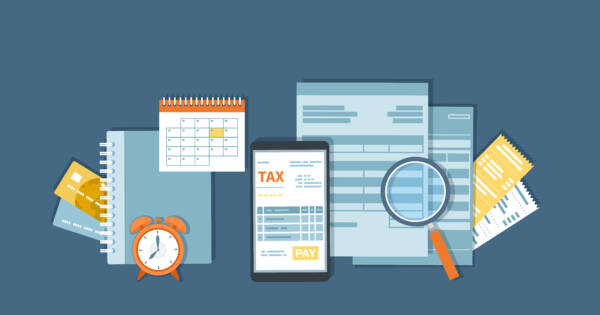Whether you work as an employee for a company or as a freelancer/contractor, there are certain benefits to having a job — beyond just a paycheck. For contractors, for example, there are tax deductions you can take as business expenses that employees may not be able to claim. On the other hand, employees often have employer-paid benefits that positively affect their tax liability. For employees, certain business expenses can be deducted as miscellaneous expenses on Schedule A. They can be deducted only to the extent that they total more than 2 percent of your adjusted gross income (AGI). This 2 percent rule is mentioned as it applies to the benefits in this list.
[Editor’s Note: Miscellaneous Itemized deductions have been removed since tax reform.]
If you’re wondering whether to work as a contractor/freelancer or full-blown employee, take a look at the list. It will help as you’re considering the tax ramifications of your decision.
10. Taxes
As an employee, your employer pays certain federal and state taxes on your behalf with every paycheck. Since you don’t see these payments, you may not be aware of them. They are a great benefit to your bottom line, however, because if your employer wasn’t paying them, you would be. Employment taxes include:
- Social Security and Medicare;
- Federal income tax withholding;
- Federal unemployment tax; and
- State taxes.
Freelancers, contractors and other self-employed workers know the effect these taxes can have on their bottom line because they must pay the taxes themselves in the form of the self-employment (SE) tax. SE taxes include Social Security and Medicare payments, which contribute to your coverage in the Social Security system.
The benefits of Social Security — and the reason you must pay in, even as a self-employed person — include retirement, disability, survivor and hospital insurance (Medicare). The SE tax rate for 2020 is 15.3 percent, which includes 12.4 percent for Social Security and 2.9 percent for Medicare. Self-employed people can deduct the employer-equivalent portion when calculating their AGI [source: IRS Self-Employed].
9. Insurance
Full-time employees, and even a few fortunate part-timers, often have employer-paid or partially paid health, life and disability insurance. If that is the case with your employer, be sure you’re participating in those programs as fully as possible. However, keep in mind that employer-sponsored plans may offer less insurance than you and your family need based on your financial circumstances.
For freelancers, contractors and those without employer-sponsored health plans, the Affordable Care Act requires you and everyone in your family to have qualifying health insurance, called minimum essential coverage. If you don’t want or need insurance coverage, you can apply for an exemption and see if the government agrees with you.
However, if you don’t have minimum essential coverage or receive your exemption, you will pay a penalty when you file your tax return. For 2014, the penalty, known as the Individual Responsibility Payment, is generally the greater of 1 percent of your household income or $95 per adult and $47.50 per child, with a per-family cap of $285.
[Editor’s Note: The last two paragraphs no longer apply. President Trump stripped this requirement from the ACA. You no longer have to pay this fee if you can’t find essential minimum coverage.]
You may also want to consider private life and disability insurance, especially if you are the major breadwinner in your family. These two types of insurance can help protect your family in the event something happens to decrease or eliminate your ability to earn an income.
8. Flex Spending Account
Another benefit — this one applies to employees only, not to the self-employed — is a medical flexible spending account (FSA). This is an account you pay into throughout the year with pretax dollars. The money can then be used for many medical expenses that aren’t covered by your health insurance, such as deductibles and co-pays, eyeglasses, dental visits and prescription medications.
The Affordable Care Act lowered the annual contribution limit to this type of account to $2,750. As it gets toward year-end, check with your account administrator or review your account to be sure you have used all of the money in it. The U.S. Treasury has changed the rules so that it’s possible to carry over $500 to the next year, but your employer must sign up for this benefit.
Again, check with your plan administrator. If yours is a use-it-or-lose-it account and you have money left at the end of the year, it will vanish in a bureaucratic labyrinth, never to be seen again [source: Bankrate].
7. Retirement Account
If you’re an employee and your company offers a 401(k) or similar retirement savings account, put in as much money as you’re allowed and can afford, especially if your employer matches or contributes to the plan as well. Often, contributions are made pre tax, which means the IRS won’t tax you on as much income.
Another upside, for most plans: You can change your contribution amount at any time, so as it nears the end of the calendar year, check with your plan administrator to see if you’ve maxed out your contributions — and do so if you haven’t and can afford it. Contribution limits vary depending on the type of plan and your age, so again, check with your administrator for the rules about your plan [source: IRS Retirement].
The self-employed also have options for saving for retirement. You may want to open an IRA, or individual retirement account. These plans offer ways to save for retirement and provide tax benefits as well. IRAs come in two varieties: traditional and Roth. With a traditional IRA, you make contributions that may be fully or partially deductible, and any money in your IRA is not taxed until it is distributed.
With a Roth IRA, you can’t deduct the contributions on your taxes, but qualified distributions are tax-free. Like 401(k)s, IRAs are also subject to contribution limits. In 2020, the max you could contribute was the lesser of $6,000 or the sum total of your income for the year. If you’re over 50, they let you play catch up, and you may contribute $7,000.
6. Home Office Deduction
The self-employed can often deduct expenses related to a home office. If you’ve worked from home and tried to claim the home office deduction in the past, you’ll be relieved to know that in 2013 the IRS finally offered up the simplified home office deduction.
With the simplified deduction, you still have to meet two basic requirements. First, you must use a portion of your house regularly and exclusively for business. You can’t cram a desk into the baby’s room and claim the entire nursery, for example. Second, it must be your principal place of business.
If you meet the above requirements, here’s the way the simplified deduction works:
- Use a standard deduction of $5 per square foot of space used for business, up to a max of 300 square feet (91 square meters).
- Claim allowable itemized deductions, such as mortgage interest, utilities or real estate taxes on Schedule A.
- Don’t worry about the home depreciation deduction. It isn’t allowed with the simplified option.
If you’re one of those people who just likes doing paperwork, you’re welcome to continue figuring your home office deduction using the more complicated method. The IRS still allows it [source: IRS Simplified].
5. Office Supplies and Equipment
If you run a business out of your home, you can now use the simplified home office deduction and often deduct a portion of expenses such as your mortgage payment, utilities, Internet and phone bill, as well as equipment like a computer, printer, phone, fax and office supplies.
Don’t forget auto expenses, beyond mileage, if you use your car for business. Generally, you can’t take the mileage deduction and also deduct expenses like insurance, gas and maintenance.
Check out the IRS’s rules about these deductions, or talk to your accountant about them. For employees, miscellaneous itemized deductions are a thing of the past. So if you claimed them in the past, be aware that the laws have changed.
4. Travel
Employees may deduct unreimbursed travel expenses, including travel to and from one workplace to another. For example, if you primarily work at home but have to travel to an office or other work site, that may be deductible. Similarly, trips out of town, including the cost of travel, related meals, hotel costs, business phone calls and dry cleaning or laundry may be deductible or partially deductible. In addition, the cost of convention or trade shows that will benefit your business may be deductible. [source: IRS Employee]
The self-employed can generally treat business travel like any other business-related expense and deduct most, if not all, of the costs. Keep excellent records, however. This is one of those categories of expenses that can make the IRS raise its collective eyebrows if the deductions seem out of line with your income.
3. Clothes
The IRS has guidelines for deducting the cost and upkeep of work clothes, starting with these two requirements:
- You must wear them as a condition of your employment.
- The clothes are not suitable for everyday wear [source: IRS Publication 529].
According to the guidelines, the clothing must be more than distinctive. For example, painters who are required by their employers to wear all white may not deduct the cost, as white pants and shirts may be worn every day, and away from work. Some employees who may be able to take the work-related clothing deduction include professional athletes, postal workers, law enforcement officers, firefighters, musicians and theatrical workers. In addition, the cost of safety items such as shoes, boots, safety glasses and hard hats may be deductible.
Generally, all of these expenses may be deducted as part of the costs of doing business if you’re self-employed.
2. Education
One way people can get ahead in their jobs is by continuing their education. If you’ve taken classes related to your job this year, you’ll be glad to know some of the expenses — for both employees and freelancers/contractors — may be deductible. The IRS has specific rules related to deductions for education: To be deductible, education expenses must “maintain or improve your job skills” or be “required by your employer or by law to keep your salary, status or job” [source: IRS Educational].
However, there are a couple of caveats. Education expenses are not deductible, even if they meet the two requirements, in the event that the education is “part of a program that will qualify you for a new trade or business or is needed to meet the minimal educational requirements of your trade or business.” Expenses that may be deductible include tuition, books, supplies, lab fees and the like, as well as transportation and travel costs.
1. Job Hunt
[Editor’s Note: Job hunting expenses are no longer tax deductible under tax reform.]
When this article was first written, certain expenses related to job hunting were tax deductible. Things have changed, though. These expenses are no longer deductible. We were originally going to replace this section with “Moving Expenses.” However, research into the matter showed that most moving expenses are no longer deductible either. The lone exception is if you’re in the military and had to relocate for work.
With a new presidential administration taking over on January 20, 2021, we will have to wait and see which changes might be made to tax laws in the coming years. Whatever happens, we will keep you updated!
 Shutterstock
Shutterstock







